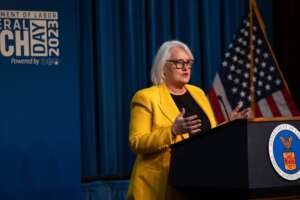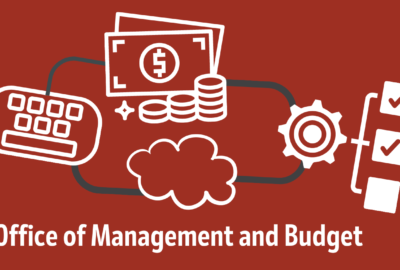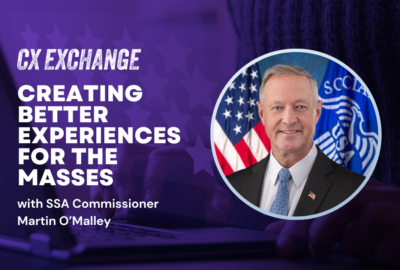A new push by OMB to get a handle on 10,000 federal websites
OMB, GSA and the USDS are providing the policies, tools and know-how to help agencies improve digital services like federal websites more quickly.
Over the last six months, agencies inventoried over 10,000 public-facing federal websites and identified their top websites with the most user traffic.
This may have been the first time agencies completed such a website inventory as it was part of the requirements under the Digital Experience (DX) memo from Office of Management and Budget released in September.
Clare Martorana, the federal chief information officer, said over the last few decades as agencies have launched federal websites or web pages, it wasn’t always based on standards or even using a .gov domain.

But now with the inventory and the strong encouragement in the Digital Experience memo to use the U.S. Web Design System standards, Martorana said agencies will have a better idea of their entire ecosystem and what they need to do to secure it and improve the user experience.
“Part of what we’re working on with our agency partners is they’re scanning those websites, they’re understanding what are.gov domains. Oftentimes, agencies have .edu and sometimes they have .com sites. We’re looking across this ecosystem, making sure that they have the tools in place to be able to do that work. Then we do talk to them, and share best practices,” Martorana said in an interview with Federal News Network on Ask the CIO. “We stood up recently the DX Council, which is taking a lot of working groups that have already existed in government for many years, with really passionate federal employees that have been doing this work, bringing them together and then sharing some of these insights so that we can go on this journey together.”
Martorana said NASA, for example, used a new scanning tool to find more and more websites used by the public and their science and research communities.
“They’re sharing with the DX Council and the community, so that other agencies that might not be quite as far along are able to learn from that and talk to those people, figure out what tools that they’ve used, and then that’ll benefit the other agencies as we move forward,” she said.
The DX Council, which launched in February, includes a Digital Experience Delivery Lead from each agency. The council serves as the primary interagency advisory body for assisting in the governmentwide implementation of the 21st Century IDEA and related digital experience activities.
Driving accessibility through standards
One of the council’s focuses is helping agencies take more advantage of the U.S. Web Design System standards.
Robin Carnahan, the administrator of the General Services Administration, said agencies using the design standards average about 1 billion page views a month.
“What that does is make sure government websites are accessible to everyone,” Carnahan said. “Our job is to come up with a system that is easy to adopt and integrate into their existing functionality. I think that this has been around long enough and proven out enough that folks are ready to say, ‘yes.’ But there’s still more to do. We’ve got a big percentage using the system, and now I’m encouraged the state governments are using it, local governments are using it. I’d encourage international folks to take a look at it, too. It’s all open source and reusable. In fact, like, we ought to do more of that.”
Carnahan said the continued growth of Login.gov is another example of the sharing of tools and capabilities to make digital services better and easier to use. She said about 40 agencies and 50 million active users are taking advantage of the shared service. GSA announced in April it would start a pilot in May to allow individuals to verify their identity online using facial recognition technology that meets standards set by the National Institute of Standards and Technology’s 800-63-3 Identity Assurance Level 2 (IAL2) guidelines.
“We want to continue to build on Login.gov, and expand the use of that, expand our ability to do facial matching because that’s the thing that many of our customers are looking for, in a way that’s equitable, and in line with our values as a country,” she said.
The policies from OMB and tools from GSA all come together when the U.S. Digital Service helps agencies modernize applications and services.
USDS, SSA case study
Mina Hsiang, the administrator of the USDS at OMB, said her team has worked on 20 projects across a dozen agencies over the last few years.
She said a project USDS worked on with the Social Security Administration to improve the agency’s website is good example of all of the tools, policies and processes coming together.
“They didn’t have a ton of monitoring on the back end to figure out what are people actually doing. What pages are they stuck on? Where transactions fill up? We helped them implement screeners for example. So some people can get their new social security card online, some people cannot; you could go through the entire process of trying to apply for it only to discover that you are not eligible for it. So we helped them to understand what are the high volume transactions, to make it easier upfront for someone to have an early interaction that helps them understand [if they are eligible],” Hsiang said. “We did that using infrastructure that came from GSA, and helping work with the security team to identify what are the top priority transactions that we need to simplify.”
USDS helped SSA implement US web design standards so citizens found the website language easier to understand. She said her team also put in place monitoring tools to create a continuous feedback loop to continue to improve the user’s experience.
Martorana said successes like SSA and USDS are helping to show both what can and should be done, and there are tools and help out there.
“We have to make sure these teams have all of those capabilities available to them. It’s really important in the 21st century, as we’re working with these modern tools and trying to meet customers’ expectations, we are utilizing products and services that are instant, accessible and trusted. So we are working really hard together as a team to make sure that we’re meeting that mark,” said Martorana, who also recently issued a six-month update on the progress against the digital experience memo.
Hsiang added the opportunity for large-scale transformation is here for every agency ranging from the IRS to the Centers for Disease Control and Prevention to the Department of Veterans Affairs, and every other agency.
“We try and focus on the projects that can have the largest impact for our investment in them. Some of that is about the criticality of the service for individuals and their circumstances, and some of that is about the longevity of the change,” she said.
Copyright © 2024 Federal News Network. All rights reserved. This website is not intended for users located within the European Economic Area.
Jason Miller is executive editor of Federal News Network and directs news coverage on the people, policy and programs of the federal government.
Follow @jmillerWFED







